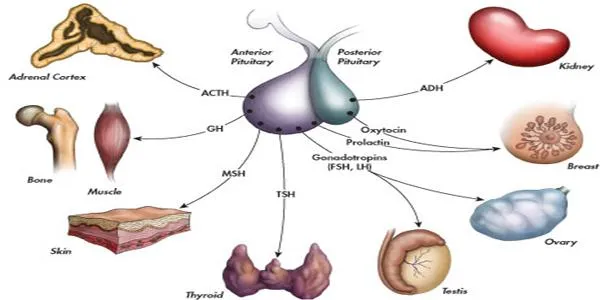Pituitary Gland Hormones
Hypothalamus is the master organs controlling the pituitary gland hormones as it stimulates, coordinates and regulates the functioning and output of all other endocrine glands in the body.
Because of its close association with hypothalamus, the pituitary organ is known as the "master gland".
It is responsible for the secretion of nine releasing factors (hormones), which play a significant role in growth, maturation, reproduction, sexual functioning, birth control, lactation and so on.
The releasing factors of the master gland include oxytocin, TSH, ACTH, FSH, LH, vasopressin (ADH), MSH, prolactin and growth hormone (GH).
It is important to be noted that not all of these hormones are actually synthesized by the gland, but, some of them, like vasopressin and oxytocin, are produced by hypothalamus and transferred to posterior pituitary lobe for storage and secretion.
Here follows a brief description of the releasing factors of pituitary organs with their type, composition and function.

Oxytocin
This pituitary gland hormone is a peptide hormone composed of 9 amino acids, or simply a nanopeptide, it works on positive feedback mechanism and is responsible for the various processes of sexual reproduction in mammals. Synthesized by hypothalamus and stored & secreted by neurohypophysis (posterior pituitary gland), the love hormone contributes to orgasm ans performs pre & post child-birth functions, while assisting in labor and milk ejection.
Thyroid-Stimulating Hormone
A type of glycoprotein hormone, it is also known as thyrotropin or simply TSH, and is secreted by thyrotropes in the anterior pituitary. The releasing factor is responsible for triggering thyroid gland, which in response to it, syntheses and secretes T4 or thyroxine. T4 is converted into T3 or triiodothyronine which stimulates metabolism in all the living tissues and cells of the body.
Adreno-Cortico-Tropic Hormone
As it is responsible for stimulating the secretion of releasing factors from adrenal gland, corticotropin (an alternative term for ACTH) is known as a tropic hormone, consisting of 39 amino acid polypeptide compound. It binds on the receptor cells of adrenal cortex and initiates both rapid short-term and slow long term actions for the synthesis and release of steroid hormones, like corticosteroids.
Follicle Stimulating Hormone
A glycoprotein biochemical compound released by neurohypophysis (or anterior lobe of pituitary gland), FSH regulates and maintains various developmental, reproductive, growth and maturation processes in humans. Some of the functions are similar in both the sexes, like maturation of germ cells, while others are different in different genders, for example, the growth and maturation of ovarian follicles in the ovary in females, and formation of secondary spermatocytes in males.
Luteinizing Hormone or Lutropin
A glycoprotein hormone synthesized and secreted by the gonadotrophs in the anterior pituitary gland (or adenohypophysis), LH is essential for reproductive processes both in males and females. In males, it acts upon and stimulates leydig cells of the testis while, in female, theca cells in the ovaries are supported and stimulated. For its role in triggering the production of testosterone in males, it is also known as ICSH (or Interstitial Cell-Stimulating Hormone).
Vasopressin
Also known as ADH or Anti-Diuretic Hormone, it is a peptide hormone that is synthesized by hypothalamus, and stored & released by posterior lobe of pituitary gland (or neurohypophysis). The major function of this releasing factor is the regulation and retention of body's fluid content by recollecting or reabsorbing water from the tubules in the kidney. It this way, Anti-Diuretic Hormone is said to play a significant role in the maintenance of homeostasis (regulation of water retention) in the body.
Melanocyte Stimulating Hormones
Precisely known as Intermedins, it is a collection of releasing factors produced and secreted by the intermediate lobe of the pituitary gland (or hypophysis). The melanocytes, present in hair and skin of humans, are stimulated by the action of these hormones. In response to the triggering of MSH, a process of melanogenesis occurs in which melanin (one of the naturally occurring dark pigments) is synthesized and secreted to bring coloring, especially black, to hair and skin in humans and other animals.
Prolactin
One of the most significant biochemical compounds in human body and other animals because of the variety of functions it performs, it is a polypeptide hormone. The lactotrop (an alternative term for prolactin) has been reported to have as many as 300 functions, but it is named after its principal role in lactation. Along with the production and ejection of milk in female mammals, it contributes to immune system, salt and water balance, reproduction, metabolism, brain and behavior.
Growth Hormone (GH)
Consisting of a single polypeptide chain of 191 amino acids, it is produced, stored and released by the anterior pituitary gland (adenohyposhysis). As the very name indicates, the somatotropin (an alternative term for GH) is responsible for the reproduction, growth and regeneration body cells. Any abnormal production and release of this biochemical compound results in severe conditions, particularly, related to physical health, for example, decrease and access in its production leads to dwarfism and gigantism (or acromegaly) in an individual.


